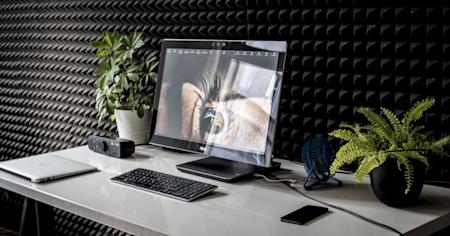Remote access is now woven into everyday work, whether a designer needs files after office hours, an IT engineer troubleshoots a server in another city, or a sales representative demos software from a hotel laptop. Remote desktop solutions make these tasks possible by streaming a live view of one machine to another, while sending your keyboard and mouse actions back the other way. Choosing the right platform affects latency, data safety, and how quickly teammates acclimate to the tool. This guide compares widely used remote-desktop applications across Windows, macOS, Linux, and web browsers so you can match features to real-world needs.
What Is a Remote Desktop Solution?
A remote desktop solution is software that lets you view and control a distant computer, mobile device, or virtual machine through an encrypted connection. The local screen displays whatever appears on the remote monitor, while your keystrokes and clicks manipulate that remote system in real time. Businesses rely on the technology for help-desk support, cloud-server management, and collaborative troubleshooting. Developers test apps on multiple operating systems without buying extra hardware, and power users pull forgotten documents from home PCs while traveling.
Remote Desktop Solutions for Windows
Microsoft ships Remote Desktop Protocol (RDP) inside every Windows Pro installation, giving administrators built-in access without extra licenses. RDP integrates with Active Directory, Group Policy, and Kerberos authentication, making it a natural fit for domain environments. It works best on local networks or through a Remote Desktop Gateway that tunnels sessions over HTTPS. When WAN links suffer congestion, RDP’s older codecs can stutter, though recent versions add adaptive graphics improvements.
Third-party options widen the feature set. TeamViewer pairs a random numeric code with optional two-factor authentication, allowing technicians to hop onto a client PC even if no static IP exists. AnyDesk uses its lightweight DeskRT codec for smooth video at low bitrates, and portable executables install in under a minute. Chrome Remote Desktop lives inside the Chrome browser, enabling quick personal sessions through Google accounts without firewall changes.
Each product solves different problems. TeamViewer shines for ad-hoc support and unattended access, AnyDesk prioritizes speed on weak connections, and Chrome Remote Desktop offers a no-cost option for occasional personal use.
Remote Desktop Tools for macOS
Apple sells Apple Remote Desktop (ARD), a management platform that pushes updates, locks screens, and copies files across Mac fleets. Enterprises appreciate its batch-scripting features, yet licensing cost and macOS-only scope push mixed-OS shops toward cross-platform suites.
TeamViewer, Splashtop, and AnyDesk provide native macOS clients, supporting Retina display resolutions and multi-monitor setups. Splashtop’s Mac streamer encodes GPU-accelerated video, helping creative teams render Adobe Premiere timelines remotely with minimal lag. When security policies disallow always-running agents, browser-based sessions like those in Zoho Assist let a user grant temporary permission via a one-time code.
Performance on macOS depends on metal graphics acceleration and network uplink capacity, so test each tool over Wi-Fi and wired Ethernet before rollout.
Remote Desktop Access for Linux Users
Administrators often maintain Linux servers through SSH, yet graphical environments still matter for desktop publishing, medical imaging, or CAD workloads. Remmina offers a GTK interface that supports RDP, VNC, and SSH in one tabbed window. For pure open-source needs, TigerVNC delivers TLS-encrypted VNC sessions, while XRDP allows Windows clients to connect using the familiar RDP protocol.
Cross-platform vendors increasingly compile Linux versions of their agents. TeamViewer offers .deb and .rpm packages, AnyDesk supports snap installations, and Splashtop provides a tarball for various distros. These agents simplify mixed-OS fleets because policy management spans every operating system from one console.
Some of the remote desktop tools for customer support stands out when help-desk agents require rapid, attended sessions and file-transfer workflows. Splashtop’s business plans, linked via their dedicated solution page, illustrate pricing tiers, AES-256 encryption, and technician management features. They balance cost with enterprise controls suitable for MSPs and internal service desks.
Power users may still favor SSH with X11 forwarding for lightweight tasks, but graphical remote desktops reduce learning curves when non-technical staff need occasional access.
Web-Based and Cross-Platform Remote Desktop Options
Browser-centric tools strip away local installs, ideal for organizations with tight endpoint-management rules. Chrome Remote Desktop runs entirely inside Chrome or Edge after installing a lightweight host. AnyDesk WebClient opens sessions through WebRTC without extra plugins. Zoho Assist launches from any modern browser and stores recordings in Zoho Desk for ticket audits.
Web variants excel at quick access across locked-down laptops or thin clients, yet they sometimes trail native apps on frame-rate and peripheral redirection. High-definition video, USB device pass-through, or multiple 4K monitors may require the full desktop client. Evaluate bandwidth usage, too, because browser encoding can consume more data on busy screens.
Key Features to Look For in a Remote Desktop Solution
Security tops the list. Sessions must encrypt traffic end-to-end, support two-factor authentication, and log every connection for audits. Look for compliance attestations such as SOC 2, HIPAA alignment, or GDPR readiness if you operate in regulated sectors.
Performance metrics include round-trip latency, frame-rate stability, and adaptive bitrate behavior when networks fluctuate. Some codecs prioritize text clarity while others maintain smooth animation. Test on both fiber and cellular hotspots to gauge worst-case scenarios.
Convenience matters: drag-and-drop file transfers, clipboard sharing, remote printing, and session recording save technicians countless minutes. Multi-monitor mapping lets a support rep view dual-screen layouts exactly as the user sees them.
Verify support for Windows, macOS, Linux, Android, and iOS so every employee can connect from whichever device fits their workflow. Finally, compare licensing structures-seat-based, concurrent, or subscription tiers-to avoid overpaying for unused capacity. Well-rounded research should also reference Microsoft’s official documentation for RDP hardening tips.
Comparison Table: Pros and Cons at a Glance
| Solution | Best For | Setup Complexity | Stand-out Perks | Potential Drawbacks |
| Microsoft RDP | Windows domain networks | Moderate (ports, gateway) | Native integration, no extra fees | Limited cross-platform host support |
| TeamViewer | Mixed OS help desks | Easy (ID & password) | Wake-on-LAN, VR support | Commercial tier cost scales quickly |
| AnyDesk | Low-latency creative work | Very easy | Lightweight codec, file sync | Fewer enterprise integrations |
| Chrome Remote Desktop | Occasional personal use | Simplest | Free, browser-only | No MFA, limited admin controls |
| Splashtop | Small biz & education | Easy | HD video, granular roles | Mobile gestures require license |
| Zoho Assist | Help-desk SaaS links | Easy | Built-in chat, ticket logging | Peak performance trails native apps |
| Remmina (Linux) | Open-source admins | Moderate | Multi-protocol tabs | UI less polished |
| Apple Remote Desktop | Mac fleets | Easy for Macs | Script automation | Mac-only, license fee |
Use Cases and Best Fit
- IT Support Teams juggle dozens of sessions daily and need multi-technician dashboards, file transfer, and session recording. Splashtop SOS or Zoho Assist Enterprise fit these scenarios.
- Freelancers require quick links into home PCs with least hassle. AnyDesk’s portable build or Chrome Remote Desktop do the job.
- Small Businesses weigh affordability against support features. TeamViewer Small Business or Splashtop Business Pro balance those priorities.
- Enterprises demand single sign-on, role-based permissions, and SIEM exports. TeamViewer Tensor or Microsoft RDP with Azure AD and Remote Desktop Gateway integrate well in that context.
Final Tips Before You Decide
Always run real-world pilots: install the host on a test PC, simulate poor Wi-Fi conditions, and verify how clipboard copy, audio, webcams, and printing behave. Confirm that your chosen vendor publishes timely patches and that you can force auto-updates. Remember, remote desktop software effectively opens a privileged pathway into your network; security reviews should match those you apply to VPNs or SaaS tools.
The National Cyber Security Centre’s guidance on locking down remote connections. These resources highlight configuration best practices beyond merely installing software.
Conclusion
Every major operating system now offers at least one mature remote desktop solution, and cross-platform vendors add powerful alternatives. By matching security requirements, performance expectations, and budget constraints to the feature sets detailed above, teams can empower staff to access resources from anywhere without sacrificing safety or productivity. Test two or three contenders, measure latency under load, review authentication logs, and then roll out the tool that slots most naturally into your workflow.
Frequently Asked Questions
Do browser-based remote desktops encrypt traffic?
Yes. Most browser solutions use WebRTC secured by DTLS or TLS, ensuring end-to-end encryption similar to native applications. Always confirm that the vendor enforces HTTPS and allows administrators to mandate two-factor authentication.
Can one license cover multiple operating systems?
Vendors like TeamViewer, Splashtop, and AnyDesk issue per-seat or concurrent licenses usable across Windows, macOS, Linux, Android, and iOS. Verify host-versus-viewer restrictions because some plans limit how many unattended machines you may register.
How do remote desktop tools impact CPU usage on the host?
Screen encoding consumes resources, especially at high resolutions or frame rates. Modern codecs leverage GPU acceleration when available. Benchmarks show AnyDesk and Splashtop using roughly 15–25 percent CPU on a quad-core machine during HD video playback, whereas older VNC variants can spike higher. Adjust color depth and frame rate settings to balance performance with bandwidth.









